Citation Systems
A Guide to APA 7th Edition
What is APA?
APA (American Psychological Association) is a common writing style in social science subjects. The stylistic choices range from formatting font all the way to abstracts and citations. The general basics to follow are: 12-point font, Times New Roman, 1-inch margins, and double spaced. While APA is a specific system, it is important to keep in mind some professors don’t require, or even want, all aspects within the style system. It is always important to be aware of all aspects within the different writing styles, but to follow your professors guidelines and expectations in the end as they will be the one giving a grade.
*The most recent version of APA is the 7th edition. There is an older 6th edition that some professors may want to use, but this page will mainly be focused on the 7th edition and student papers. If you have questions about the 6th edition, please use this resource.
Are Headings Needed?
Headings are typically used at the writers’ discretion. Professors may sometimes require that sections are broken up, but APA has various levels of headings and usually the writer can choose how in-depth they would like to be. There are 5 levels of headings one can use in APA. Whether they are all used or not, they should always go in order. For example, a writer should not go from level 1 to level 4 in order to break up information, they would need to go from level 1 to level 2. The levels are used based on sections and subsections.
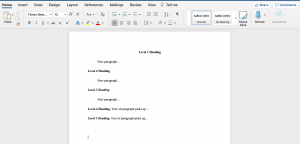
What is a Title Page?
The title page in APA is going to be a stand-alone front page with information such as your name, the class, your professors name, etc. There are specifics when it comes to spacing, and sometimes an author note may be included. One main difference between APA 6th and 7th edition is the lack of a running head. If you don’t know what that is, that is completely fine, it is just how the title was stated in the header (very top of the margins).
Title Page:
- For APA 7th edition, all you need in the header is a page number. The page number should be in the upper right hand corner, and be sure it starts on the title page then follows on the remaining pages.
- The title of the paper should be the first thing seen on the page. It should be bolded and centered. The title should also be around 3 lines down from the top margin.
- Your name should be next. This information should still be centered but it is not bolded. Your name should be about two lines below the title of the paper.
- The rest of the information is only spaced with one line and goes: school, class, professor, and due date.
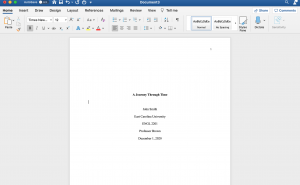
What is an abstract? Do you need it?
An abstract is essentially a summary that touches on all important details and data, including the ending points. A simple yet effective way to think about it is a movie trailer that gives away the ending. It should be short and to the point. Think to yourself when writing it, can someone read this and understand what my paper is about and why? Whether or not you need it is up to the professor. Many times in student papers a professor will say it is not necessary, especially if the paper is only a few pages; however, sometimes a professor will want one with a 2-3 page paper simply to make sure the students are knowledgeable on how to craft them.
Quick Tips:
- The word “Abstract” should be centered and bolded on a new page (even though the abstract is short, it has a page to itself and the paper itself should begin on the next one)
- No indentation is needed for an abstract
- Abstracts may vary in length, but they tend to be 150-250 words
- Summarize main points and data
- Usually there are no citations or outside sources used within it
Is anything needed to begin the paper?
As everyone is aware, starting off the assignment can often be a difficult task. There are a lot of questions going on in your head and it can be a confusing time to put thoughts into lines on a page. The first thing to do in APA is restate the title of the paper as a level 1 heading (bold and centered on its own line). If you have doubts about starting the paper or are unsure how to brainstorm, please visit here.
What are citation politics?
Sara Ahmed (2013) defines citation practices “as a rather successful reproductive technology, a way of reproducing the world around certain bodies.” Citation politics is about reproducing sameness. When you are consistently citing the same type of scholar (white, male authors), you are reproducing a narrow set of knowledge. The knowledges of Black, Indigenous, and People of Color, trans, women, non-binary, disability and queer writers are silenced when you only value one voice. When you cite someone, you are legitimizing that knowledge.
For more information on citation politics, listen to this expert panel.
Who should we cite?
You should question who you are citing and why you are citing them. What kinds of knowledge, expertise, and research are you incorporating in your work? Are you citing underrepresented scholars as part of your core argument not just footnotes? Whose identities are missing from your reference page? Do your citations reproduce the status que? How does who you cite change your argument or the research narrative?
Why do you need citations?
In-text citations and references are used to give proper credit to the source information you are using in your own work. Plagiarism is a very big deal, even if it is done unintentionally, because it is essentially stealing someone else’s work in order to fill your own paper. This can be done in multiple forms, but it can also be easily avoided with the right knowledge. There are two ways source information may be used: paraphrasing and directly quoting. Paraphrasing tends to be a good route because you can use source information while still letting your own voice come through. Just remember, even if there are not quotation marks being used, anytime source information is included, a citation must also be included. Directly quoting is when you are taking information word-for-word from a source. When directly quoting, quotation marks should be included at the beginning and ending points of the quote.
What do in-text citations in APA look like?
Citations vary from system to system and in APA the main information needed is the author last name, the year of publication, and a page number if it is a direct quote.
Paraphrasing in-text citation: *Source information paraphrased* (author last name, year of publication).
Direct quotes in-text citation: “Source information” (author last name, year of publication, page number).
The period always comes at the end of the citation rather than the end of the sentence. With direct quotes, a page number is also required so that the precise location of your quote can be found. A page number can also be included when paraphrasing, it just isn’t mandatory.
For more examples, check out this link.
What to do if information is missing?
There are usually ways to get around missing information if you are having trouble locating a necessary part of the citation. Sometimes there isn’t an author listed because the piece was actually written by an organization, in this case you would list the organization as the author. In other cases, an author/organization may not be listed so using the title is acceptable. If there is no date listed, the abbreviation “n.d.” may be used. If there is no page number, using information that will help locate where the information came from is best, this can be a section name, heading, or paragraph number. The abbreviation for paragraph is “para.”
What is et al. and when to use it?
Et al. is a Latin phrase that means “and others”, it is used to simplify and shorten author lists for citations. In APA 7th edition, et al. should be used for in-text citations if there are 3 or more authors in a citation. When there are 3 or more authors, only the first author name needs to be listed in the citation followed by “et al.”. This may look like: (Smith et al., 2017).
*Et al. is not used in the References section, but the rules do differ here if there are more than 3 authors. If there are up to 20 authors to one source in the references section, all the names should be listed out. Anything past 20, the first 19 names are to be listed and then an ellipsis (…) follows the 19th name and the citation finishes as usual.
What do references look like?
In APA, the final page(s) with the more detailed source information should be labeled “References”, this should be centered and bolded at the top of a new page. These references should be in alphabetical order and have a hanging indent. A hanging indent is when every line after the first of each entry is indented. The challenging part with references can be that there are many different source types and each source types has slight differences in its citation. The first thing you need to do is figure out what kind of source you are using.
Book (Printed) Example: Author Last name, first initial. Middle Initial(optional). (Year of Publication). Title of Book: Subtitle. Publisher Name. DOI(optional)
Scholarly Article Example: Author Last name, first initial. (Year). Title of article. Title of Journal, Vol.(Issue), page numbers. DOI or URL
Webpage Example: Last name, First initial. (Date of publication). Title of page. Site name. URL
If it was written by a group/organization rather than single person, that can go in place of author name.
For a more exhaustive list of source types, information, and details, Purdue OWL can be visited here.
Please remember to check what kind of source you are using so you know how to cite it. While it can seem easy to choose a random style to cite, figuring out what kind of source you are using and citing it properly is how you correctly give credit and avoid plagiarizing.
Learn more about what plagiarism is and why it matters here.
Before turning in your assignment, feel free to use this checklist to make sure you’ve touched on the general APA elements. Keep in mind that your professor may have additional/slightly different requests, though. If you have any questions or need clarity, please feel free to make an appointment at the UWC.
References
Lee, C. (2011, November 3). The Proper Use of et al. in APA Style. American Psychological Association. https://blog.apastyle.org/apastyle/2011/11/the-proper-use-of-et-al-in-apa-style.html#:~:text=in%20APA%20Style,-by%20Chelsea%20Lee&text=One%20of%20these%20is%20the,repeated%20referencing%20shorter%20and%20simpler
MorningSide College. (2020, October 12). APA Citations (7th ed.): Abstracts. https://morningside.libguides.com/APA7/abstracts
Purdue OWL. (n.d.) APA Headings and Seriations. https://owl.purdue.edu/owl/research_and_citation/apa_style/apa_formatting_and_style_guide/apa_headings_and_seriation.html
Purdue OWL. (n.d.). In-Text Citations: Author/Authors. https://owl.purdue.edu/owl/research_and_citation/apa_style/apa_formatting_and_style_guide/in_text_citations_author_authors.html
Purdue OWL. (n.d.). Reference List: Author/Authors. https://owl.purdue.edu/owl/research_and_citation/apa_style/apa_formatting_and_style_guide/reference_list_author_authors.html
Purdue OWL. (n.d.). Reference List: Electronic Sources. https://owl.purdue.edu/owl/research_and_citation/apa_style/apa_formatting_and_style_guide/reference_list_electronic_sources.html
What is MLA?
MLA (Modern Language Association) is a writing style used in many humanity studies, such as language arts. While each style system has differences, remembering to cite and follow guidelines is important no matter what. General formatting guides (that are subject to change based on professor requirements) tend to be: 1 inch margins, 12 point font, ½ inch indentations for new paragraphs, double spaced, and an easy-to-read font, such as Times New Roman. A basic list of MLA formatting guidelines can be looked at here.
Are headings needed?
Headings are not so much needed in MLA, but they can be used for organization if the writer wants to add them. For basic essay (as opposed to chapter books) headings, it is recommended that headings are numbered, but there is more free reign here. There is also a way to make headings that aren’t numbered and there are 5 levels of potential headings, though they do not have to all be used. They are separated based on information subsections and do not all have to be used.
These are the headings for an unnumbered format:
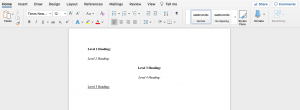
If you choose to do numbered headings, they can look like the following:
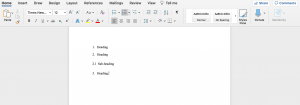
Headings are used at the writers discretion though, so do whatever you’re comfortable with based on the information that is being written about.
How to format the heading?
With MLA, there is no dedicated title page, but there is a certain way to lay out writer information in order to state your name, class, date, etc. The information goes on the top left-hand side of the first page of the assignment. The paper itself begins one line below the title, it goes as follows:
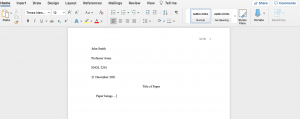
The header only needs the author last name and page number, both in the upper right-hand corner of the header (top margins) itself.
The date is stated as day, month (not abbreviated) and then year.
What are citation politics?
Sara Ahmed (2013) defines citation practices “as a rather successful reproductive technology, a way of reproducing the world around certain bodies.” Citation politics is about reproducing sameness. When you are consistently citing the same type of scholar (white, male authors), you are reproducing a narrow set of knowledge. The knowledges of Black, Indigenous, and People of Color, trans, women, non-binary, disability and queer writers are silenced when you only value one voice. When you cite someone, you are legitimizing that knowledge.
For more information on citation politics, listen to this expert panel. https://www.youtube.com/watch?v=BWAaEZx0-MA
Who should we cite?
You should question who you are citing and why you are citing them. What kinds of knowledge, expertise, and research are you incorporating in your work? Are you citing underrepresented scholars as part of your core argument not just footnotes? Whose identities are missing from your reference page? Do your citations reproduce the status que? How does who you cite change your argument or the research narrative?
Why do you need citations?
In-text citations and references are used to give proper credit to the source information you are using in your own work. Plagiarism is a very big deal, even if it is done unintentionally, because it is essentially stealing someone else’s work in order to fill your own paper. This can be done in multiple forms, but it can also be easily avoided with the right knowledge. There are two ways source information may be used: paraphrasing and directly quoting. Paraphrasing tends to be a good route because you can use source information while still letting your own voice come through. Just remember, even if there are not quotation marks being used, anytime source information is included, a citation must also be included. Directly quoting is when you are taking information word-for-word from a source. When directly quoting, quotation marks should be included at the beginning and ending points of the quote.
Learn more about plagiarism and what plagiarism looks like here.
What do in-text citations look like in MLA?
MLA in-text citations follow a parenthetical style with author last name and page number, there is no comma in between this information so it may look as follows: (author last name page #). Or (Smith 25). The period of the sentence actually comes after the end parenthesis rather than the end of the sentence. This is the same for paraphrased information or a direct quote. Keep in mind that whenever any kind of source information is used, an in-text citation must be present to give credit.
What to do if information is missing?
Sometimes you may run into instances where a page number isn’t listed or source information seems to lack an author name, but that is okay and there are ways to work around that. If an author name is not present, using the title of the work is acceptable. If the title is overly long, using a shortened version of it is also okay. Just remember basic rules here, if the title is from a shorter work, quote the title and if it is from a longer piece of work (like a book), the title should be italicized. If the page number is missing, simply using the author name should be sufficient.
What is et al. and when to use it?
Et al. is a Latin phrase that means “and others”, it is used to simplify and shorten author lists for citations. Et al. should be used in MLA when a source has 3 or more authors. When using et al. the first author name should be listed followed directly by “et al.” and then the page number. For example, (Smith et al. 27). There are still no commas used and the period is still put after the end parentheses.
The rule for et al. is similar for the works cited page as well, et al. should be used if there are 3 or more authors in one source. Only the first author name should be listed immediately followed by “et al.” and then the rest of the citation should carry on as normal.
What does the Works Cited page look like?
The page(s) at the end of the paper that have the full citations listed should be labeled “Works Cited” in MLA. This should be centered at the top of a new page, but not bolded.
The citations themselves should be listed in alphabetical order and have a hanging indent. A hanging indent is when every line after the first of each citation is indented ½ inch.
An important note to keep in mind is that each source type has different kinds of citations, some are more similar than others but they all have slight differences that need to be acknowledged and carried out in order to give proper credit to the source itself.
The first thing you need to figure out is what kind of source you’re using, below you will find a few different examples of common source types:
Book (Printed) Example: Author last name, author first name. Title of Book. Publisher, Publication Date.
Scholarly Article Example: Author last name, author first name. “Name of Article.” Title of Publication, vol. #, issue #, year of publication, pp. (page numbers used), DOI or URL.
Webpage Example: Author last name, author first name (if available). “Title of Page.” Name of Site. Version number if available, publisher, publication date, DOI or URL, Date of Access.
*If author is missing, using the title is okay.
For a more exhaustive list of source types, information, and details, Purdue OWL can be visited here.
Please remember to check what kind of source you are using so you know how to cite it. While it can seem easy to choose a random style to cite, figuring out what kind of source you are using and citing it properly is how you correctly give credit and avoid plagiarizing.
For anymore questions, feel free to look at the following sample document that looks at the overall MLA set up, or make an appointment with a UWC consultant at any time.
View the MLA sample document here.
Also keep in mind that professor requirements are subject to change so when in doubt, ask your professor and follow their guidance.
References
Lee, C. (2011, November 3). The Proper Use of et al. in APA Style. American Psychological Association. https://blog.apastyle.org/apastyle/2011/11/the-proper-use-of-et-al-in-apa-style.html#:~:text=in%20APA%20Style,-by%20Chelsea%20Lee&text=One%20of%20these%20is%20the,repeated%20referencing%20shorter%20and%20simpler
Purdue OWL. (n.d.). MLA General Format. https://owl.purdue.edu/owl/research_and_citation/mla_style/mla_formatting_and_style_guide/mla_general_format.html
Purdue OWL. (n.d.). MLA In-Text Citations: The Basics. https://owl.purdue.edu/owl/research_and_citation/mla_style/mla_formatting_and_style_guide/mla_in_text_citations_the_basics.html
Purdue OWL. (n.d.). MLA Works Cited Page: Books. https://owl.purdue.edu/owl/research_and_citation/mla_style/mla_formatting_and_style_guide/mla_works_cited_page_books.html
What is CMOS?
Chicago style, also known as CMOS or the Chicago Manual of Style, is another citation system that offers a variety of specifics when it comes to writing assignments. This system is unique for a number of reasons, but something important to note is that there are two types of ways it can be carried out based on the content/course. The two versions of Chicago are the Notes-Bibliography System (NB) and the Author-Date System. Regardless of what is being used, always keep in mind that your professor may have differing requirements, and you should look closely at their directions to ensure you are completing tasks based on those requirements. Some basics to the system are as follows: use 1-to 1.5-inch margins, choose a readable font, double space, and have a dedicated title page.
Notes-Bibliography System:
This may be considered the more traditional Chicago system with its setup and citation format. The ending citation page(s) is typically labeled “Bibliography”. There may be footnotes used as necessary, and are used in the humanities/arts mainly.
Author-Date System:
This system may resemble APA qualities and is used by those working in the social sciences. The differences in the systems speak to the overall organization but does not change the specific content.
Are headings needed?
As with most systems, the headings can be used at the writer’s discretion. There are five levels of headings that can be used based on sections and subsections. A writer may decide they need no headings for one assignment, while they may use all five on another. Just note that if you are going to use them, they must be used in order; you cannot use a level 1 heading and then skip to a level 4 heading. It should go from level 1 to level 2 and so on. Below you can find how each level is formatted as needed:
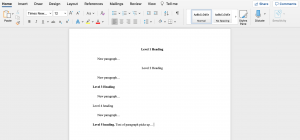
What is a title page?
The title page is similar for both the NB and Author-Date system. A title page is what identifies the paper with the title, writer name, and other important information. The setup should be:
- The title of your paper centered a third of the way down the paper
- Several lines later should come your name, still centered
- One single spaced line in between your name should be the class information
- Lastly, one single line below the class should be the due date
Some things to keep in mind are that there is no page number on this page. The page count begins on the following page where the content itself starts. The title is normally in all caps as well. Please refer below for an example of the layout.
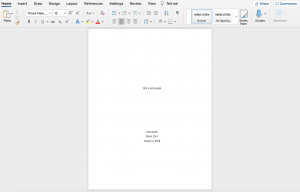
What are citation politics?
Sara Ahmed (2013) defines citation practices “as a rather successful reproductive technology, a way of reproducing the world around certain bodies.” Citation politics is about reproducing sameness. When you are consistently citing the same type of scholar (white, male authors), you are reproducing a narrow set of knowledge. The knowledges of Black, Indigenous, and People of Color, trans, women, non-binary, disability and queer writers are silenced when you only value one voice. When you cite someone, you are legitimizing that knowledge.
For more information on citation politics, listen to this expert panel. https://www.youtube.com/watch?v=BWAaEZx0-MA
Who should we cite?
You should question who you are citing and why you are citing them. What kinds of knowledge, expertise, and research are you incorporating in your work? Are you citing underrepresented scholars as part of your core argument, and not just footnotes? Whose identities are missing from your reference page? Do your citations reproduce the status quo? How does who you cite change your argument or the research narrative?
Why do you need citations?
In-text citations and references are used to give proper credit to the source information you are using in your own work. Plagiarism is a very big deal, even if it is done unintentionally, because it is essentially stealing someone else’s work in order to fill your own paper. This can be done in multiple forms, but it can also be easily avoided with the right knowledge. There are two ways source information may be used: paraphrasing and directly quoting. Paraphrasing tends to be a good route because you can use source information while still letting your own voice come through. Just remember, even if there are not quotation marks being used, any time source information is included, a citation must also be included. Directly quoting is when you are taking information word-for-word from a source. When directly quoting, quotation marks should be included at the beginning and ending points of the quote.
Please keep in mind that different source types have different ways they should be written; in order to give proper credit, sources must be set up a very specific way and knowing the types of sources you are using is critical.
Learn more about what plagiarism is and why it’s important here.
Citations
NB in-text citations/Footnotes:
In this particular style system, you may not see the typical parenthetical in-text citations that are otherwise common. Within NB, the writer should use superscripts in place of an in-text citation and a footnote at the bottom of the page where source information was used in order to give credit. A different superscript should be used for different source information, even if it is coming from the same source, and multiple different citations should be in the footnote if multiple sources were used throughout the page. The footnote sources look similar to the citations on the bibliography page. There are just a few differences in them. The corresponding citations in the footnote should have the same number in front of them as the superscript shows within the paper itself. Let’s say you are using source information from a book:
*source information should go here.*1 The paper continues as normal. *More source information is used from same source.2 The paper goes on as normal. *Source information from new source.*3
The footnote citation would look like:
- Author First Name Last Name, Book Title (Location of Publication: Publisher, Year of Publication), page number.
- , *list page number(s)*
- Author First Name Last Name, Book Title (Location of Publication: Publisher, Year of Publication), page number.
In Chicago, “ibid” can be used when the same source is being used consecutively for different information. Ibid means “in the same place” and can be used rather than listing the citation again. Keep in mind that ibid can only be used if the source information is consecutive, meaning that if you use another source in between, you will have to re-list the whole citation rather than using the shortcut.
NB Bibliography:
Similar to other style systems, when representing your full list of citations at the end of the paper, they should start on a new page with a centered title. In the NB system, this page should be labeled “Bibliography” and there should be about two lines in between this title and the first entry. The entries should go in alphabetical order and have a hanging indent. A hanging indent is when every line after the first of each entry is indented ½ an inch. The bibliography entries are similar to the footnote entries. The main difference is how the author name is written. Rather than it being First Name Last Name, the bibliography style should be Last Name, First Name. Some common source type examples are below:
Book (Printed) Example: Author last name, author first name. Title of Book. Location of Publication: Publisher, Publication Date.
Scholarly Article Example: Author last name, author first name. “Name of Article.” Title of Journal, vol. #, issue # (Year of Publication): page numbers used, DOI or URL.
Webpage Example: Author last name, author first name (if available). “Title of Page.” Name of Site. Publisher, publication date. URL.
*If there is no known author, just go straight into title of page.
Author-Date in-text citations:
The Author-Date system has some similarities overall to APA, but there are some important differences to note; so, copying the APA system will not work. In-text citations for this do go by author name and date, but there is no comma to separate them. A page number can be included as well to help locate information, but is not required. A parenthetical citation may look like this: (Smith 2011).
Like usual, the period should follow the parentheses.
Author-Date References:
With this system, the page(s) at the end of the paper with full citation information should be labeled “References”, and it should be centered. The entries should go in alphabetical order and have a hanging indent. A hanging indent is when every line after the first of each entry is indented ½ an inch. Below you may find the layout of some common source types:
Book (Printed) Example: Author last name, author first name. Year of Publication. Title of Book. Location of Publication: Publisher.
Scholarly Article Example: Author last name, author first name. Year of Publication. “Name of Article.” In Title of Journal, vol. #, issue #, page numbers used, DOI or URL.
Webpage Example: Author last name, author first name (if available). Year of Publication. “Title of Page.” Name of Site. Publisher. URL.
*If there is no known author, just go straight into title of page.
Please remember to check what kind of source you are using so you know how to cite it. While it can seem easy to choose a random style to cite, figuring out what kind of source you are using and citing it properly is how you correctly give credit and avoid plagiarizing.
What to do if information is missing?
It isn’t uncommon for a piece of citing information to not be present when looking at material. When this happens, there are ways to go around it that still provide proper credit to the source. If the author is missing, see if it was written by an organization instead; and if so, use that in place of the author. If there is no organization either, using the title of the article, webpage, book, etc., will suffice. Depending on the type of work, it should go in quotations (if it is a short work, such as an article) or italics (for longer works, such as books). If there is no date, Chicago style states that putting a date accessed (as in the day you are finding the source information) should be sufficient. This is done by writing “Accessed” followed by the month, date, and year you are looking at the source.
What is et al. and when to use it?
Et al. is a Latin phrase that means “and others”. It is used to simplify and shorten author lists for citations. In the case of Chicago, et al. should be used for in-text citations/footnote citations when there are 4 or more authors. Only the first author should be listed when this occurs followed by “et al.”, and then the rest of the citation as needed. Take this example in an Author-Date style citation:
(Smith et al. 2009).
For the bibliography/references page, et al. should be used if there are more than 10 authors. Only the first 7 authors should be listed in the citation, then followed by “et al.” and the rest of the citation as normal.
For a general overview, feel free to look at the following checklist that goes over the basic CMOS, and/or make an appointment with a UWC consultant at any time.
Access our CMOS Basics Checklist here.
References
The CMOS. (2017). Author-Date: Sample Citations. https://www.chicagomanualofstyle.org/tools_citationguide/citation-guide-2.html
Lee, C. (2011, November 3). The Proper Use of et al. in APA Style. American Psychological Association. https://blog.apastyle.org/apastyle/2011/11/the-proper-use-of-et-al-in-apa-style.html#:~:text=in%20APA%20Style,-by%20Chelsea%20Lee&text=One%20of%20these%20is%20the,repeated%20referencing%20shorter%20and%20simpler
Purdue OWL. (n.d.). CMOS Author-Date Guidelines. https://owl.purdue.edu/owl/research_and_citation/chicago_manual_17th_edition/documents/20180709CMOSADPoster.jpg
Purdue OWL. (n.d.). CMOS Author Date PowerPoint Presentation. https://owl.purdue.edu/owl/research_and_citation/chicago_manual_17th_edition/cmos_formatting_and_style_guide/cmos_author_date_powerpoint_presentation.html
Purdue OWL. (n.d.). Chicago Manual of Style 17th Edition. https://owl.purdue.edu/owl/research_and_citation/chicago_manual_17th_edition/cmos_formatting_and_style_guide/chicago_manual_of_style_17th_edition.html
Purdue OWL. (n.d.). CMOS Notes and Bibliography Guidelines. https://owl.purdue.edu/owl/research_and_citation/chicago_manual_17th_edition/documents/20180702CmosNBPoster.jpg
Purdue OWL. (n.d.). General Format. https://owl.purdue.edu/owl/research_and_citation/chicago_manual_17th_edition/cmos_formatting_and_style_guide/general_format.html
Purdue OWL. (n.d.). Periodicals. https://owl.purdue.edu/owl/research_and_citation/chicago_manual_17th_edition/cmos_formatting_and_style_guide/periodicals.html
Purdue OWL. (n.d.). Web Sources. https://owl.purdue.edu/owl/research_and_citation/chicago_manual_17th_edition/cmos_formatting_and_style_guide/web_sources.html
University of Portland. (2020, September 28). Chicago Style Citation Guide: Short Form and Ibid.. https://libguides.up.edu/chicago/short_form
